Dental Implants
Comprehensive Tooth Replacements for Healthy Smiles
 If you’ve lost one or more natural teeth, there’s no better solution for replacing them today than modern dental implants. Because dental implants replicate every part of the natural tooth – including the root hidden under the gum line – they promote better oral health, offer seamless aesthetics, and are likely to last for the rest of the patient’s life. At Adirondack Periodontics, Dr. Davis is a uniquely qualified specialist who can guide patients through this transformative process with precise, comprehensive success. Contact our Plattsburgh, NY location today to schedule your first appointment!
If you’ve lost one or more natural teeth, there’s no better solution for replacing them today than modern dental implants. Because dental implants replicate every part of the natural tooth – including the root hidden under the gum line – they promote better oral health, offer seamless aesthetics, and are likely to last for the rest of the patient’s life. At Adirondack Periodontics, Dr. Davis is a uniquely qualified specialist who can guide patients through this transformative process with precise, comprehensive success. Contact our Plattsburgh, NY location today to schedule your first appointment!
The Benefits of Dental Implants
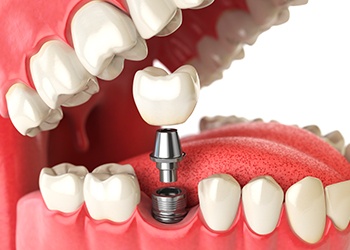
Unlike dentures or dental bridges, dental implants replicate natural tooth structure and replace the entire tooth from the bottom up. As a result, they have many advantages over other restoration options, including the following:
- Better oral health: When you lose a tooth, the jawbone can quickly lose density. Under the gumline, dental implants stimulate bone growth in the jaw, keeping it healthy and strong. This, in turn, can prevent future tooth loss.
- Preserving other healthy teeth: Dental bridges require using the surrounding teeth as anchors. Down the road, this dependence can cause decay and even tooth loss in these affected teeth. In contrast, dental implants do not impact your remaining healthy teeth, helping them stay that way for longer.
- Longer lifespan: Dentures last about 5 to 7 years, and dental bridges between 7 and 10 years before needing to be replaced. With the proper care, dental implants can last a lifetime!
- Additional stability: Unlike dentures, which are known to slip, dental implants are firmly held in place by being fully integrated with the jawbone, meaning you can eat and talk with complete confidence.
Indications for Dental Implants
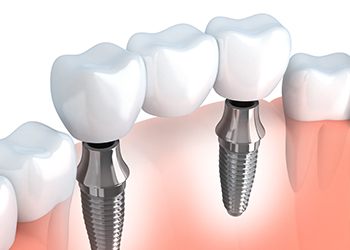
Another advantage of using dental implants is that they can replace one tooth, multiple teeth, or even an entire smile. The type of restoration that you need will directly depend on the number of teeth you’re missing and your desired results.
Missing Single Tooth
When replacing a single tooth with a dental implant, the first step is for our team to surgically insert the implant itself into the tooth’s original socket. Once Dr. Davis has successfully completed this step, the patient will need to undergo a period of healing where their natural oral tissue will slowly incorporate the biocompatible implants, resulting in a strong foundation for the eventual restoration. A dental crown will finally be anchored over the placed implant, blending right in alongside natural teeth.
LEARN MORE ABOUT SINGLE TOOTH IMPLANTS
Missing Multiple Teeth
If the patient has lost teeth that appear consecutively along the same arch, an implant-retained bridge may be their best option to rebuild the dental structure durably and seamlessly. Dr. Davis will plan to surgically place two implants, one on either side of the affected gap. The implants will serve as “anchors” that hold the attractive bridge in place and facilitate its function. This type of reconstructive method is much-preferred to traditional bridges, which anchor over natural teeth that must be filed down.
LEARN MORE ABOUT IMPLANT BRIDGES
Missing All Teeth
The versatile power of dental implants can even rehabilitate cases of extensive tooth loss! This method is also more cost-effective, as Dr. Davis will place a small number of dental implants at strategic positions throughout the affected area instead of allotting one implant per lost tooth. The new prosthetic may be fixed permanently in place, or it may remain removable in nature – this will depend on the patient’s current level of oral health and their personal preferences.
LEARN MORE ABOUT IMPLANT DENTURES
Advanced Dental Implant Procedures
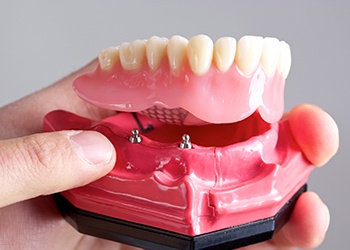
When a natural tooth is removed from the mouth, the surrounding bone that supported it will quickly begin to deteriorate. Thankfully, Dr. Davis can perform socket preservation, which maintains the tooth’s original socket long enough for a dental implant to be successfully placed. Our team will insert bone material into the socket, either using tissue from elsewhere on the patient’s body or a synthetic source. This will keep the socket’s width and height reliably stable. For the placement of dental implants to be successful, there has to be a certain amount of healthy jawbone structure in the area. If advanced periodontal disease or tooth loss have robbed you of a strong jawbone, Dr. Davis will be happy to perform a bone grafting procedure. After folding the gums and removing any problematic bacteria, he will attach new bone material. This tissue will encourage the growth of new, healthy bone that’s fully capable of supporting a dental implant.
LEARN MORE ABOUT BONE GRAFTING
Understanding the Cost of Dental Implants

Although dental implants have the highest upfront cost out of all the tooth replacement options, they could end up being the wisest financial investment. Unlike dentures and dental bridges, which require frequent adjustments and replacements, dental implants can last for 30 years or longer with the proper care.
Also, because each patient is different, the cost associated with dental implant placement will vary from case to case. So many factors go into calculating the cost of dental implants, including the number of implants that are necessary, their size, whether additional procedures (like bone grafts) are needed, and much more. At your consultation, we will review all your needs to provide an accurate estimate for treatment. Then, our experienced team will work with you to maximize your insurance benefits and help you understand your payment options.
Learn More About Cost of Dental Implants
Dental Implant FAQ’s
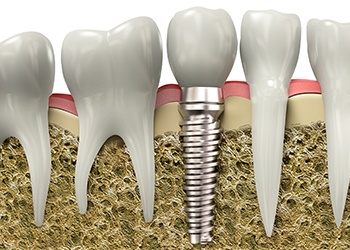
Before you begin tooth replacement, you want to make sure you have all the information. We completely understand and want you to feel comfortable and confident going into treatment. That’s why we’re providing the answers to a few common questions that patients have asked us in the past.
What Causes Dental Implant Failure?

Over 95 percent of the time, dental implants are successful. However, implant failure is possible in some situations. To prevent this, first and foremost, you need to find a highly trained periodontist like Dr. Davis. He has the experience and knowledge to perform the procedure correctly and mitigate the potential complications for implant failure and problems like peri-implantitis, a form of periodontal disease that targets the gum and bone that supports your implant. On the other hand, a general dentist may not be as familiar with these possible complications of implant placement. At Adirondack Periodontics, we know how to increase the odds of implant success, helping you enjoy your healthy smile once again.
In the long term, dental implants can fail if they are not properly maintained through daily brushing and flossing and going in for your dental checkups and cleanings twice every year.
How Long is the Dental Implant Process?
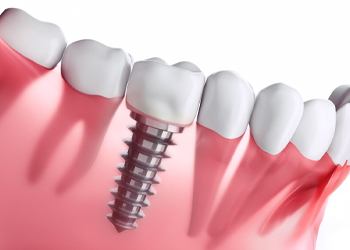
From the beginning of the implant placement procedure to getting the restoration put on top, it can take several months. That’s because the tissue and jawbone need time to heal and surround the implant. For a better idea of an estimated timeline in your particular case, you’ll need to schedule a consultation with Dr. Davis.
How Do I get Started with Dental Implants?

The first step on the path to your fully restored smile is scheduling a consultation with Dr. Davis. He will review your case and formulate a personalized treatment plan that will meet your specific needs. So don’t delay! Contact our Plattsburgh office today!

 Exclusively Periodontics & Procedures in Implant Dentistry
Exclusively Periodontics & Procedures in Implant Dentistry